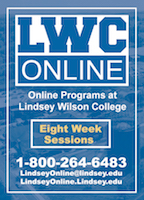| ||||||||||
Dr. Ronald P. Rogers CHIROPRACTOR Support for your body's natural healing capabilities 270-384-5554 Click here for details 


Columbia Gas Dept. GAS LEAK or GAS SMELL Contact Numbers 24 hrs/ 365 days 270-384-2006 or 9-1-1 Call before you dig Visit ColumbiaMagazine's Directory of Churches Addresses, times, phone numbers and more for churches in Adair County Find Great Stuff in ColumbiaMagazine's Classified Ads Antiques, Help Wanted, Autos, Real Estate, Legal Notices, More... 
|
Tom Chaney: Stealing Time Of Writers And Their Books: Stealing Time. Tony Hillerman's A Thief of Time concerns looting of artifacts from ancient Native American burial sites. This column first appeared 30 March 2008. The next earlier Tom Chaney column: "From Where the Sun Now Stands, I Will Fight No More Forever" By Tom Chaney Stealing Time I've got one of those atomic clocks here in the bookstore. Generally it marks time unobtrusively. Haven't decided just yet what time is, but the clock does pretty well with a questionable concept. Until last Wednesday evening the clock caused no disruption. But right in the midst of an erudite book discussion it took a fit. All of a sudden the hands started spinning around. It had already "sprung forward" an hour a week or so back. Now we were tumbled about five hours into the future in less than five minutes. I 'spect the clock could have gone on forever marking off high-speed time, but it was merely proclaiming the violent death of a battery. Ironically, I have been rereading Tony Hillerman's A Thief of Time. If you don't know Hillerman and his tales of Native Americans in the four corners region of the Southwest, then you'd better get with it. A Thief of Time concerns the looting of artifacts from ancient burial sites. The looters are referred to as thieves of time -- disturbers of the sacred rest of ancestors. The pottery thieves are also tied in with murder. And, of course, murder is itself a stealing of time. The aging Navajo policeman, Joe Leaphorn, is set to retire. Emma, his wife, has died as a result of unexpected complications from surgery; Joe is tired; already on terminal leave, he intends to lay down his gun and badge. Emma's presence hovers by his side. Her death by cancer has stolen time that Leaphorn bitterly regrets. The story goes something like this. Dr. Bernal, a young anthropologist who specializes in Anasazi pottery is missing. Leaphorn, knowing that Emma would have wanted him to solve that mystery, gets on the case. Leaphorn teams up with Jim Chee, the younger Navajo cop. Then a number of murders are committed -- all of which involve illegal grave robbery at Anasazi ruins. One of the murders is with Bernal's own gun. Is she a killer faking her own disappearance? Early in his career, Leaphorn had protected the disturbed son of Harrison Houk, a wealthy rancher and seller of artifacts of questionable legality. Houk's son Brigham had murdered his mother and two siblings. Having discovered the son's hat in a swollen river, Leaphorn had not pursued the chase for the boy any further. The search for Bernal leads to the elder Houk whose murder leads Chee and Leaphorn to the discovery of Ms Bernal. Hillerman is one of those writers to whom I find myself returning time and again. Re-reading one of his novels is akin to gazing into a deep pool. Shadows move across the surface of the water changing the shape of the image below. One realizes that the pool itself is not still; that there are subtle movements of current far beneath the surface also distorting the image. The ability to evoke this vision is a matter of great skill on the part of the writer. William Faulkner has it. Any entry into Yoknapatawpha County gradually shows shadowy glimpses of the whole. With Hillerman a trip down any wash or up any canyon is apt to provide the reader an entry into the deep pool of the personal past of character, the tribal past of the Navajo, and the racial past extending centuries back to the Anasazi. The title of the novel is ironic in a number of ways. If an anthropologist who excavates and studies ruins is thereby "stealing time" from the dead, then that same anthropologist by careful study is also giving new life to ancient civilizations. And not just to civilizations. Dr. Bernal is tracing the work of a specific Anasazi potter with specific techniques. In a word, she is "restoring time" to that long dead potter. We have just celebrated the season of a most significant resurrection a world away in another desert culture. In both instances the grave does not mark the end of the story. And time is cheated of its finality. Tom Chaney can be found telling stories, planning his next meal, and occasionally selling books at THE BOOKSTORE Box 73 / 111 Water Street Horse Cave, Kentucky 42749 270-786-3084 Email: Tom Chaney This story was posted on 2013-03-31 03:19:00
Printable: this page is now automatically formatted for printing.
Have comments or corrections for this story? Use our contact form and let us know. More articles from topic Tom Chaney: Of Writers and Their Books:
Tom Chaney: From Where the Sun Now Stands Tom Chaney: Just Live With It Tom Chaney: A Matter of Honor Tom Chaney: Wilson W. Wyatt Tom Chaney: Dark as the Inside of a Badger Tom Chaney: John Grisham - back on track Tom Chaney: Sue Grafton at "T" Tom Chaney: Mary James dishes it out Tom Chaney: Dan Sickles: Roguish Rapscallion Tom Chaney: Mary Lincoln's Insanity View even more articles in topic Tom Chaney: Of Writers and Their Books |



|
||||||||
|
| ||||||||||
|
Quick Links to Popular Features
Looking for a story or picture? Try our Photo Archive or our Stories Archive for all the information that's appeared on ColumbiaMagazine.com. | ||||||||||
|
Contact us: Columbia Magazine and columbiamagazine.com are published by Linda Waggener and Pen Waggener, PO Box 906, Columbia, KY 42728. Please use our contact page, or send questions about technical issues with this site to webmaster@columbiamagazine.com. All logos and trademarks used on this site are property of their respective owners. All comments remain the property and responsibility of their posters, all articles and photos remain the property of their creators, and all the rest is copyright 1995-Present by Columbia Magazine. Privacy policy: use of this site requires no sharing of information. Voluntarily shared information may be published and made available to the public on this site and/or stored electronically. Anonymous submissions will be subject to additional verification. Cookies are not required to use our site. However, if you have cookies enabled in your web browser, some of our advertisers may use cookies for interest-based advertising across multiple domains. For more information about third-party advertising, visit the NAI web privacy site.
| ||||||||||



















































